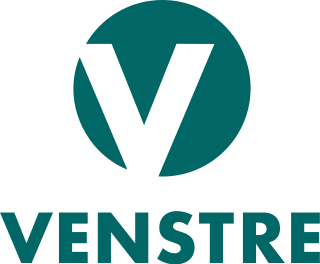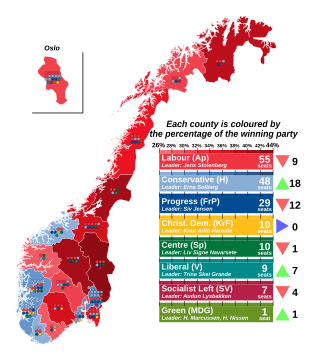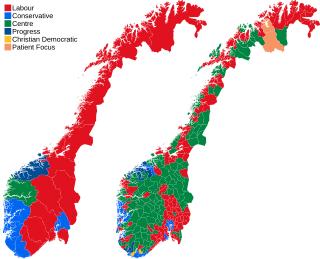The politics of Norway take place in the framework of a parliamentary, representative democratic constitutional monarchy. Executive power is exercised by the Council of State, the cabinet, led by the prime minister of Norway. Legislative power is vested in both the government and the legislature, the Storting, elected within a multi-party system. The judiciary is independent of the executive branch and the legislature.

Kjell Magne Bondevik is a Norwegian Lutheran minister and politician. As leader of the Christian Democratic Party, he served as the 33rd prime minister of Norway from 1997 to 2000, and from 2001 to 2005, making him, after Erna Solberg, Norway's second longest serving non-Labour Party prime minister since World War II. Currently, Bondevik is president of the Oslo Centre for Peace and Human Rights.

The Labour Party, formerly The Norwegian Labour Party, is a social-democratic political party in Norway. It is positioned on the centre-left of the political spectrum, and is led by Jonas Gahr Støre. It is the senior party in a minority governing coalition with the Centre Party since 2021, with Støre serving as the current Prime Minister of Norway.

The Christian Democratic Party is a Christian-democratic political party in Norway founded in 1933. The party is an observer member of the European People's Party (EPP). It currently holds three seats in the Parliament, having won 3.8% of the vote in the 2021 parliamentary election. The current leader of the party is Olaug Bollestad.

The Socialist Left Party is a democratic socialist political party in Norway. Positioned on the left-wing of the political spectrum, it is opposed to European Union and the European Economic Area membership. SV supports a strong public sector, stronger social welfare programs, environmentalism, and republicanism. As of 2018, the party had 11,385 members; the number has steadily increased since a low point in 2015. The party leader is Kirsti Bergstø, who was elected on 18 March 2023

The Centre Party, formerly the Farmer's Party, is an agrarian political party in Norway.

Parliamentary elections were held in Norway on 9 and 10 September 2001. The governing Labour Party lost seats and their vote share was the worst they had ever obtained in a post-war election. Although they still won a plurality of votes and seats, they were unable to form a government. Instead, a centre-right coalition of the Conservative Party, the Christian Democratic Party and Liberal Party was formed, led by Prime Minister Kjell Magne Bondevik of the Christian Democratic Party, with confidence and supply support from the Progress Party.
The Conservative Party or The Right is a liberal-conservative political party in Norway. It is the major party of the Norwegian centre-right, and was the leading party in government as part of the Solberg cabinet from 2013 to 2021. The current party leader is former Prime Minister Erna Solberg. The party is a member of the International Democrat Union and an associate member of the European People's Party.

The Liberal Party is a centrist political party in Norway. It was founded in 1884 and it is the oldest political party in Norway. It is positioned in the centre on the political spectrum, and it is a liberal party which has over the time enacted reforms such as parliamentarism, freedom of religion, universal suffrage, and state schooling.
The red–green coalition was a centre-left coalition of parties in Norway, constituting the Labour Party (Ap), the Socialist Left Party (SV), and the Centre Party (Sp). Unlike many other Red-Green coalitions, the "green" here was the colour of a centrist eurosceptic Nordic agrarian party rather than an actual green political movement. It governed from 2005 until Labour Party leader Jens Stoltenberg resigned his cabinet on 16 October 2013 following the coalition's defeat in the 2013 elections.

Stoltenberg's Second Cabinet was the Government of Norway from 17 October 2005 to 16 October 2013. It was a coalition between the Labour Party, the Socialist Left Party and the Centre Party, known as the Red–Green Coalition. On 9 September 2013, the coalition was defeated in the 2013 election.
Country-wide local elections for seats in municipality and county councils were held throughout Norway on 10 September 2007, with some areas polling on 9 September as well. For most places this meant that two elections, the municipal elections and the county elections ran concurrently. In addition, several municipalities held direct mayoral elections.

Parliamentary elections were held in Norway on 13 and 14 September 2009. Elections in Norway are held on a Monday in September, usually the second or third Monday, as determined by the king. Early voting was possible between 10 August and 11 September 2009, while some municipalities also held open voting on 13 September. Voters elected 169 members for the Storting, each for a four-year term. Voter turn-out in the 2009 general elections was 76.4%.
A suicide paragraph, sometimes referred to as a suicide clause, is an important term in the politics of Norway. It is a part of the formal agreements between political parties on forming a coalition government. It states that if a certain political case is brought up, the coalition is considered dissolved.

The Socialist Left Party of Norway was founded in 1975. Its history shows a long-term rise in political influence, resulting in part from its emergence from older left-wing parties, especially the Socialist People's Party. After initial political setbacks in the 1970s, the party reorganized and regained support, particularly under Theo Koritzinsky (1983–87) and Erik Solheim (1987–97). Support dropped in the 1997 parliamentary election but rose again by the 21st Century, thanks to the party's position as the only sizeable party to the left of the Norwegian Labour Party. Labour's move further to the right under Jens Stoltenberg also helped the party's rise. By 2005, the Socialist Left Party had joined the Labour and Centre parties in Norway's governing Red-Green Coalition. The party has been led by Audun Lysbakken since 11 March 2012.

The Politics and government of Oslo reflects that Oslo is the capital of Norway, and as such is the seat of Norway's national government. Most government offices, including that of the Prime Minister, are gathered at Regjeringskvartalet, a cluster of buildings close to the national parliament—the Storting.

Parliamentary elections were held in Norway on 8 and 9 September 2013 to elect all 169 members of the unicameral Storting. The centre-right coalition obtained 96 seats, while the incumbent red–green coalition government obtained 72 seats and the Green Party obtained one. The Labour Party won the largest share (30.8%) of the votes cast, with the Conservatives coming second (26.8%), after increasing its share by 9.6 percentage points.

Parliamentary elections were held in Norway on 11 September 2017 to elect all 169 members of the unicameral Norwegian Parliament, the Storting. The non-socialist parties retained a reduced majority of 88 seats, allowing Prime Minister Erna Solberg's Conservative-Progress coalition to remain in government. The Liberal Party joined the coalition in January 2018 but it remained a minority cabinet until the Christian Democratic Party joined the coalition in 2019. The three largest centre-left parties won 79 seats. The Green Party retained its single seat, while the Red Party won its first ever seat.

Parliamentary elections were held in Norway on 13 September 2021. All 169 seats in the Norwegian legislature, the Storting, were up for election.























